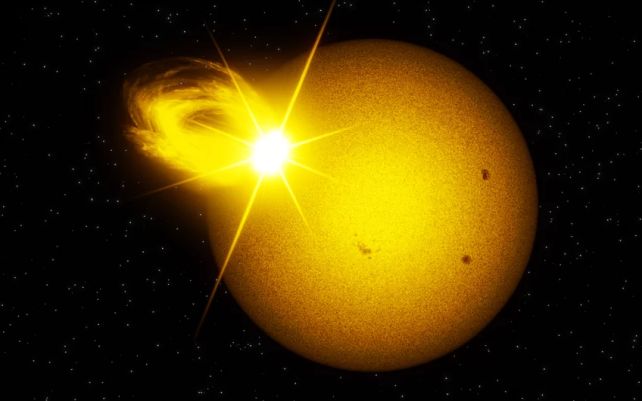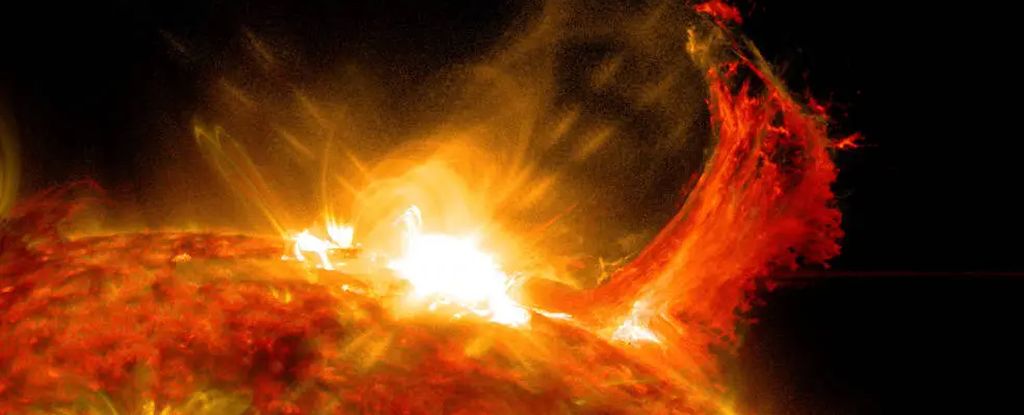Products You May Like
Our Sun is not a peaceful place. It roils with convection; its magnetic field snaps, finds a connection, snaps again. It unleashes eruptions of energy in the form of violent flares, and plasma in the form of coronal mass ejections.
Most of this activity lacks sufficient punch to harm us… but every now and then, the Sun erupts with a flare powerful enough to do serious damage. And we don’t know how often such events occur. Previous estimates have the range between once a century and once a millennium.
Well, folks, we have a problem. Because a new analysis of the eruption rates of 56,400 Sun-like stars has estimated that the Sun’s superflare rate is at the low end of that scale – once every 100 years. If that’s the case, we may be in trouble, since even the infamous Carrington Event that took place in September 1859 was only 1 percent as powerful as a superflare.
“We were very surprised,” says astronomer Valeriy Vasilyev of the Max Planck Institute for Solar System Research in Germany, “that Sun-like stars are prone to such frequent superflares.”
Figuring out how often the Sun emits a giant belch of radiation isn’t easy. We can’t exactly hit the rewind button for replays. There are records of solar activity in tree rings that give us some idea – the biggest storms induced by the Sun create a spike in carbon-14 – and nitrogen in polar ice, but these might not give us the complete picture.

By looking for stars like our Sun – G-type yellow dwarfs – and hoping to catch some of them in the act of flaring, researchers could estimate the frequency of large-scale events. There’s just one problem: we can’t always easily measure the rotation rates of these stars, and since rotation might be linked to flare activity, the information we obtain from them is incomplete.
Vasilyev and his colleagues entered their star-search with two observations in mind. Sun-like stars with measurable rotation tend to be more active than the Sun. And the stars most similar to the Sun have rotation periods that are difficult to measure.
They decided to leverage these two facts to access a large sample of Sun-like stars, by including stars with unknown rotation rates, but other characteristics as similar to the Sun as possible – that is, brightness and temperature.
They also excluded Sun-like stars with rotation periods shorter than 20 days (the Sun’s rotation period is 25 days). This is because stellar rotation slows gradually as the Sun ages; so younger stars have faster rotation rates. And younger stars are more active than older ones of the same kind.
They managed to obtain a sample of 56,450 Sun-like stars – and observed 2889 superflares on 2527 of them. This equates to a superflare rate of around once every 100 years.
So what’s the deal with the Sun? Well, we still don’t know. We know it can throw some epic tantrums. The Carrington event included both a solar flare and a coronal mass ejection that generated a powerful storm in Earth’s magnetic field; it is the coronal mass ejection that caused the most damage.
This is because coronal mass ejections can generate currents that then run along the ground and interfere with and overload infrastructure. The Carrington event wiped out telegraph systems around the world, with some overloaded grids sparking fires. There was also a large geomagnetic storm in 1989 that affected several power grids and produced blackouts.
frameborder=”0″ allow=”accelerometer; autoplay; clipboard-write; encrypted-media; gyroscope; picture-in-picture; web-share” referrerpolicy=”strict-origin-when-cross-origin” allowfullscreen>
Scientists have found nine geomagnetic storm events more powerful than the Carrington event in tree rings in the last 15,000 years, known as Miyake events. The most recent we’ve found is 774 CE. Miyake events are estimated to take place every 1,000 years or so. But a coronal mass ejection doesn’t accompany every flare the Sun spits out.
“It is unclear whether gigantic flares are always accompanied by coronal mass ejections and what is the relationship between superflares and extreme solar particle events,” explains astrophysicist Ilya Usoskin from the University of Oulu in Finland. “This requires further investigation.”
Solar flares are not without their own effects; they can temporarily disrupt high-frequency radio communications by altering the density of the ionosphere through which radio waves refract. Given, however, that the biggest geomagnetic storms on record included both a solar flare and a coronal mass ejection, it’s reasonable to be concerned about possible superflare activity from the Sun.
Since the most effective defense against a giant geomagnetic storm is accurate forecasting, the research suggests that we need to have a better understanding of how our Sun works.
“The new data are a stark reminder that even the most extreme solar events are part of the Sun’s natural repertoire,” says astrophysicist Natalie Krivova of the Max Planck Institute for Solar System Research.
The findings have been published in Science.
